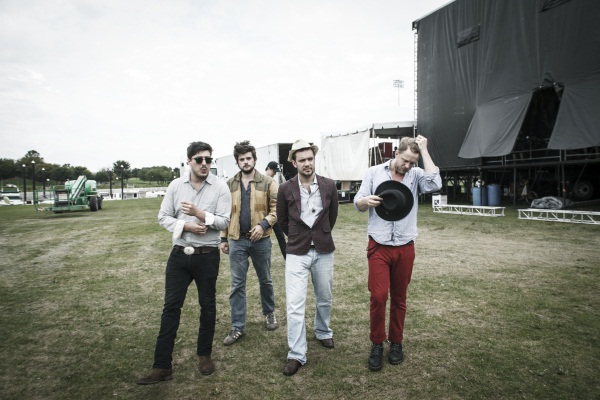Videos by American Songwriter
******
When Mumford & Sons began touring in early 2008, they played pubs and clubs, not steamboats. London and nearby Brighton were full of young bands exploring the grey area between pop, rock and folk music, and the Mumfords fit right in. They were new-school folkies with old souls, roots revivalists for the iPod generation, 21st century 20somethings steeped in the music of the Great Depression. It was a potent combination. By the middle of the year, they’d nailed their first Glastonbury performance and sold out their first show, packing 230 people into the Luminaire in north West London.
“I couldn’t get to sleep that night,” remembers bassist Ted Dwane. “I just lay in bed, thinking about how we’d filled a room to capacity, which was way beyond any expectations I had.”
Frontman Marcus Mumford agrees. “We were just ecstatic. I remember everything about the Luminaire. We were on our first EP launch, we were leaving for tour and we played “Dust Bowl Dancer” for the first time that night. I crashed the van that day, too.”
Out of excitement?
“No, just out of bad driving.”
The van eventually got repaired, and later that summer, the band headed north for a Scottish tour. They played big cities like Glasgow and Edinburgh (where “The Cave” was written during a soundcheck at Bannermans, one of the town’s smaller pubs), but they also ventured up into the Highlands. The area was gorgeous, filled with mountain peaks, lochs and small northern towns that were seldom visited by touring bands. Wherever they went, Mumford & Sons seemed to be the hottest ticket in town. It didn’t take long to realize that being strangers in a strange land had its perks.
“We went to Stornoway and all these amazing islands we’d never heard of,” Marshall remembers. “Everyone in the towns would turn up to the gigs, even though we were an unheard-of band from a different country. They were like, ‘Oh, thanks for coming to town,’ and everyone listened all the way through. We realized that if we go to places where people don’t get much music, they engage much quicker.”
People starting engaging everywhere else, too. Mumford & Sons made folk music, but they did so for a modern audience raised on rock and roll, which helped Sigh No More – the band’s 2009 debut – become a crossover hit with folkies and Top 40 fans alike. The songs were simple and anthemic, anchored by melodies and galloping chord progressions that started off softly, swept upward into a roar, then slid back to a whisper. Onstage, the guys were a whirl of sweat and strings, with Marcus slamming his foot into the ground with every quarter note, banging a four-on-the-floor drumbeat into his kickdrum. It was the only percussion they needed. The songs surged forward, as insistent as Arcade Fire.
With its big sound and straightforward hooks, the Mumford approach worked especially well at festivals, where crowds of 50,000 would howl along to “The Cave” and “Little Lion Man.” The boys played them all: Glastonbury, Bonnaroo, Reading, Leeds, Werchter, T in the Park, Lollapalooza, Coachella, the New Orleans Jazz Fest, and every mud-splattered jamboree in between. Backstage, they palled around with groups like Old Crow Medicine Show and The Avett Brothers, making friends with the competition instead of steering clear.
“We were touring with Dave Rawlings Machine, and we happened to be at Bonnaroo the same year Mumford & Sons were doing their first big Bonnaroo show,” says Old Crow bandmate Morgan Jahnig. “Their people contacted our people, asking if the guys could play “Wagon Wheel” with us during the set. They came with such a massive amount of respect for everything that we’d been doing, and they just wanted to make music with us. That was our first interaction, just spending the day with them in the hot Tennessee sun, hanging out and playing songs. For a long time, there’s been a certain kind of competition between bands, especially in rock music and some of the higher echelons of country. Everyone worries about who’s outselling who, or who can outdraw who in what market. But folk music is all about people playing music and hanging out. It’s about jumping onstage with another band, and having them jump onstage with you. We’d been missing that kind of camaraderie.”


5 Comments
Leave a Reply